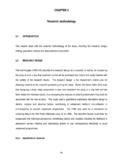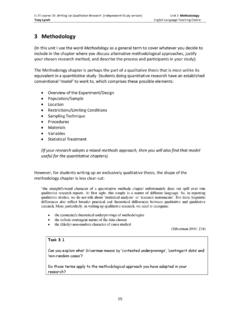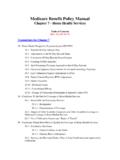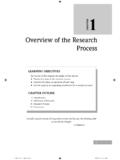Transcription of OSLO MANUAL - OECD.org - OECD
1 Organisation for Economic Co-operation and DevelopmentTHE MEASUREMENTOF SCIENTIFICAND TECHNOLOGICALACTIVITIESPROPOSED GUIDELINESFOR COLLECTINGANDINTERPRETING TECHNOLOGICALINNOVATION DATAOSLO MANUALE uropean Commission Eurostat1 TABLE OF CONTENTSC hapter 1 OBJECTIVES AND SCOPE OF THE MANUAL .. 51. INTRODUCTION .. 52. FACTORS INFLUENCING THE SCOPE OF THE MANUAL .. Understanding the innovation process and the implications for innovation policy .. Experience on the supply side .. 73. SCOPE OF THE MANUAL .. Sectoral coverage .. Innovation at the level of the firm .. Technological product and process innovation .. Diffusion of innovation .. 94. PROVIDING DATA ON THE KEY ISSUES .. Factors influencing TPP innovation .. TPP innovation activities and expenditures .. The TPP innovating firm and the impact of TPP innovation.
2 115. SOME SURVEY Approach to data Survey methods .. 126. THE RELATIONSHIP BETWEEN THE OSLO MANUAL AND OTHER INTERNATIONALSTANDARDS AND RELATED CONCEPTS .. S&T activities: the Frascati family of Other economic norms and Other related concepts and surveys .. 147. FINAL REMARK .. 14 Chapter 2 NEEDS FOR THE MEASUREMENT OF INNOVATION .. 151. INTRODUCTION .. 152. ECONOMICS OF INNOVATION ..163. TOWARDS A CONCEPTUAL FRAMEWORK .. Framework conditions .. Science and engineering Transfer Innovation dynamo .. 224. DECIDING PRIORITIES .. Six areas for investigation .. Corporate strategies .. The role of diffusion .. Sources of information for innovation and obstacles to innovation .. Inputs to innovation .. The role of public policy in industrial Innovation outputs .. How to measure and scope for measurement .. What do we want to measure?
3 : Technological product & process TPP innovations .. How should it be measured? : Choice of the survey approach .. Where should it be measured ? : Sectoral coverage .. 29 Chapter 3 BASIC DEFINITIONS ..31 INTRODUCTION .. 311. TPP INNOVATION .. 312. MAIN COMPONENTS OF TPP INNOVATION .. Technological product Technological process innovation .. 323. DIFFUSION OF TPP INNOVATIONS: INSTITUTIONAL Minimum Coverage within the 354. DISTINGUISHING BETWEEN TPP INNOVATION AND OTHER CHANGES IN THE FIRM ORINDUSTRY .. Organisational innovation .. Coverage .. Borderline cases: organisational change in manufacturing and service processes .. Other changes in products and processes .. Excluding insignificant or non-novel changes .. 37(a) Ceasing to use a process or to market a 37(b) Simple capital replacement or extension .. 37(c) Changes resulting purely from changes in factor 38(d) Custom 38(e) Seasonal and other cyclical changes.
4 38(f) Product TPP innovation and other creative product improvements .. 395. TPP INNOVATION ACTIVITIES .. Relation with implementation of TPP innovations .. The components and coverage of TPP innovation activities .. Acquisition and generation of relevant knowledge new to the firm .. 40(a) Research and experimental development .. 40(b) Acquisition of disembodied technology and know-how .. 40(c) Acquisition of embodied technology .. Other preparations for production .. 41(a) Tooling up and industrial engineering .. 41(b) Industrial design .. 41(c) Other capital acquisition .. 41(d) Production Marketing for new or improved Borderline cases .. Design .. Training .. Marketing .. 426. THE TPP INNOVATING 427. THEORY AND PRACTICE .. 433 Chapter 4 INSTITUTIONAL CLASSIFICATIONS .. 441. THE APPROACH .. 442. THE 443. CLASSIFICATION BY MAIN ECONOMIC 454.
5 CLASSIFICATION BY 455. OTHER CLASSIFICATIONS .. Type of institution .. Other .. 47 Chapter 5 MEASURING ASPECTS OF THE INNOVATION PROCESS .. 491. OBJECTIVES OF INNOVATION .. 492. FACTORS ASSISTING OR HAMPERING INNOVATION .. Sources of information for innovation .. Factors hampering innovation activities .. 523. IDENTIFYING TPP INNOVATING 534. THE IMPACT OF INNOVATIONS ON THE PERFORMANCE OF THE ENTERPRISE .. Proportion of sales due to technologically new or improved products .. Results of innovation effort .. Impact of TPP innovation on the use of factors of production .. Average cost reductions due to technological process innovations .. 555. DIFFUSION OF INNOVATION .. User sectors .. Surveys of use of advanced technologies in the manufacturing process .. 566. SPECIAL Special questions on R&D .. Questions on patents and the appropriability of innovations.
6 Questions on the acquisition/diffusion of 58 Chapter 6 MEASURING THE EXPENDITURE ON INNOVATION .. 601. THE METHOD OF MEASUREMENT .. 602. SUGGESTED BREAKDOWNS .. Bottom-up or top-down method .. Breakdown by type of expenditure .. The relation between intangible investment and TPP innovation Breakdown by type of innovation activity .. R&D Expenditure for the acquisition of disembodied technology and Expenditure for the acquisition of embodied technology .. Expenditure for tooling up, industrial engineering, industrial design and production start-up(including other expenditure for pilot plants and prototypes not already included in R&D) .. Expenditure for training linked to TPP innovation Marketing for technologically new or improved Measurement problems .. The borderline between R&D and non-R&D innovation Other Breakdown by source of funds.
7 68 Chapter 7 SURVEY PROCEDURES .. 691. POPULATIONS .. 6942. SURVEY METHODS .. Census or sample survey .. Mandatory or voluntary survey .. The frame population .. Survey methods and suitable The questionnaire .. Innovation and R&D surveys .. 723. PERFORMANCE OF SAMPLE 734. ESTIMATION OF RESULTS NON-RESPONSE 745. PRESENTATION OF RESULTS .. 756. FREQUENCY OF DATA COLLECTION .. 76 ANNEX 1 USING THE OBJECT APPROACH FOR collecting INNOVATION DATA .. 77 INTRODUCTION .. 771. SURVEYS ON SPECIFIC Issues addressed by the use of object approach Drawbacks of using the object Implementation of the object approach .. Experience in collecting data using the object approach .. Data items amenable to collection using the object approach .. Descriptive data .. Description of the main innovation .. Classification by the type of Novelty of the innovation.
8 80a) Classification by type of novelty using technical variables .. 80b) Classification by type of novelty in terms of the market .. Nature of Quantitative Innovation expenditure .. Impact of the Life cycle of the Qualitative Benefits of the innovation .. Sources of information or ideas for the Diffusion of innovation .. 82a) User sectors .. Reference period relevant to the object approach .. 822. LITERATURE-BASED INNOVATION OUTPUT INDICATORS Strengths and weaknesses of the method .. 85 ANNEX 2 THE COLLECTION OF NON-TECHNOLOGICAL INNOVATION 881. Introduction .. 882. What is included in non-technological innovation? .. 883. Experience in the measurement of non-technological innovation .. 894. What data should be collected on non-technological innovation ?.. 89 NOTES .. 905 Chapter 1 OBJECTIVES AND SCOPE OF THE is now accepted that the development and diffusion of new technologies are central to thegrowth of output and productivity.
9 But our understanding of the innovation process, and its economicimpact, is still deficient. For example, we are clearly in the throes of a major technological revolution,with the world economy being reshaped by new information technologies and by fundamental change infields such as biotechnology and materials science. Yet these radical technological shifts are not beingreflected in improvements in total factor productivity and in output growth to understand such puzzles have come to focus, in recent years, on the criticalimportance of parts of the innovation process other than R&D, in particular as they affect diffusion are areas in which we face serious difficulties, however, in particular due to the absence of reliableand systematic data. Success in refining the analysis of innovation, and in tackling the policy problems itposes, will depend in part on the ability to improve the information first version of the Oslo MANUAL , issued in 1992, and the surveys undertaken using it,notably the Community Innovation Survey (CIS) organised by the EC, showed that it is possible todevelop and collect data on the complex and differentiated process of second edition of the MANUAL takes the original framework of concepts, definitions andmethodology and updates them to incorporate survey experience and improved understanding of theinnovation process and also to take in a wider range of industries.
10 It provides guidelines by whichcomparable innovation indicators can be developed in OECD countries, and discusses the analytical andpolicy problems to which the indicators are relevant. The MANUAL has two objectives: to provide aframework within which existing surveys can evolve towards comparability; and to assist newcomers tothis important aim of the present chapter is to give an overview of the coverage and contents of the MANUAL (see Box 1), so as to help such newcomers and other non-experts use the body of the text, and also toindicate why certain types of data are or are not collected and to flag the main problems of setting normsto provide comparable INFLUENCING THE SCOPE OF THE can one decide on the appropriate scope, structure, terminology and so on forinternationally comparable data collection?
















